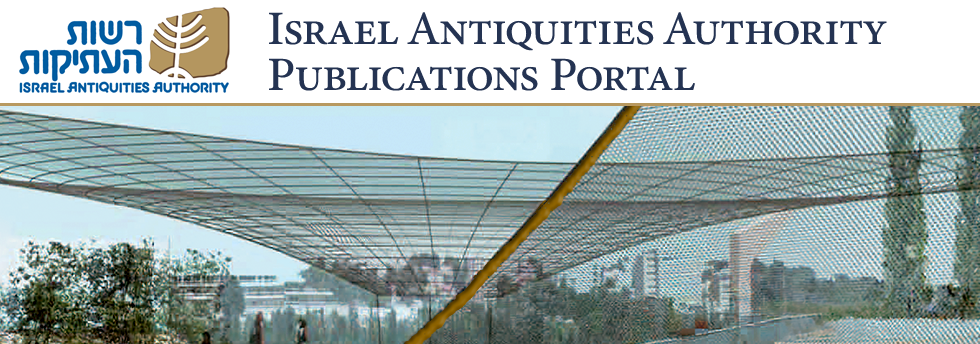Files
Download Full Text (67.2 MB)
Download Front Matter (619 KB)
Download Chpater 1: Introduction (2.5 MB)
Download Chapter 2: The Octagonal Church—Architecture and Stratigraphy (21.6 MB)
Download Chapter 3: The Entrance Atria and the Monastery—Architecture and Stratigraphy (10.1 MB)
Download Chapter 4: The Mosaic Floors (17.0 MB)
Download Chapter 5: The Inscriptions (1.3 MB)
Download Chapter 6: Architectural Elements and Liturigical Furniture (1.9 MB)
Download Chapter 7: The Coins (1.4 MB)
Download Chapter 8: The Pottery (1.2 MB)
Download Chapter 9: The Glass Finds / Yael Gorin-Rosen and Tamar Winter (1.4 MB)
Download Chapter 10: The Katisma Church in its Historical Content in the Early Islamic Period (1.8 MB)
Download Chapter 11: Summary and Discussion (596 KB)
Download References (630 KB)
Download Appendix 1: A Rhodian Stamped Amphora Handle from Kathisma (619 KB)
Download Appendix 2: List of Selected Loci and Walls (813 KB)
Description
This volume documents the excavations of the Kathisma church and monastery located on the ancient road from Jerusalem to Bethlehem. Kathisma is mentioned in Byzantine sources and pilgrimage itineraries, and identified as the holy place where Mary sat down to rest in her final stage of pregnancy before giving birth to Jesus. It played a role in the initial stages of Mary’s worship and its influence is still felt today. The octagonal church, built in the fifth century CE, is one of the most important discoveries of Early Christian architecture in the Holy Land in recent decades. The size of the church and its architectural plan, based on three concentric octagons, attest to it being designed as a pilgrimage church that could accommodate large audiences. In the Umayyad period, the church served both Muslim and Christian worshippers, as indicated by a miḥrab installed in the southern part, and the cancelation of the main apse by an Umayyad building. The splendid mosaics from this period in the southern rooms testify to artistic and iconographic influences of the wall mosaics in the Dome of the Rock. The evidence for the existence of a mosque in the Kathisma church constitutes the only archaeological evidence known to date for the ‘Covenants of ‘Umar’, which obliged Christians to relinquish areas in churches to Muslims.
EISBN
9789654067546
Publication Date
5-4-2022
Publisher
Israel Antiquities Authority
City
Jerusalem
Keywords
69 Monastery, early Christian architecture, mosaics, Byzantine church, pilgrimage
Disciplines
Historic Preservation and Conservation | History of Art, Architecture, and Archaeology
Recommended Citation
Avner, Rina, "69 | The Kathisma Church and Monastery of Mary Theotokos on the Jerusalem–Bethlehem Road Final Report of the 1992, 1997, 1999 and 2000 Excavation Seasons" (2022). IAA Reports—Monograph Series of the Israel Antiquities Authority. 3.
DOI: https://doi.org/10.69704/iaaRepV000.1996.03
https://publications.iaa.org.il/iaareports/3

Included in
Historic Preservation and Conservation Commons, History of Art, Architecture, and Archaeology Commons




Comments
This volume documents the excavations of the Kathisma church and monastery located on the ancient road from Jerusalem to Bethlehem. Kathisma is mentioned in Byzantine sources and pilgrimage itineraries, and identified as the holy place where Mary sat down to rest in her final stage of pregnancy before giving birth to Jesus. It played a role in the initial stages of Mary’s worship and its influence is still felt today. The octagonal church, built in the fifth century CE, is one of the most important discoveries of Early Christian architecture in the Holy Land in recent decades. The size of the church and its architectural plan, based on three concentric octagons, attest to it being designed as a pilgrimage church that could accommodate large audiences. In the Umayyad period, the church served both Muslim and Christian worshippers, as indicated by a miḥrab installed in the southern part, and the cancelation of the main apse by an Umayyad building. The splendid mosaics from this period in the southern rooms testify to artistic and iconographic influences of the wall mosaics in the Dome of the Rock. The evidence for the existence of a mosque in the Kathisma church constitutes the only archaeological evidence known to date for the ‘Covenants of ‘Umar’, which obliged Christians to relinquish areas in churches to Muslims.